Diet for gastritis: what can and cannot be eaten?
Gastritis is one of the most common diseases of our time. Frequent snacks and meals on the run, a wide variety of fast food, poisoning from substandard food - all of these can cause gastritis. This is probably why many people are now suffering from stomach problems. But how do you deal with them?
To do this, it is not necessary at all to constantly take drugs, the main thing in treatment is the correct and selected diet that does not cause irritation of the mucous membrane and exacerbation of the disease, but at the same time saturates the body with all the necessary macronutrients and vitamins.
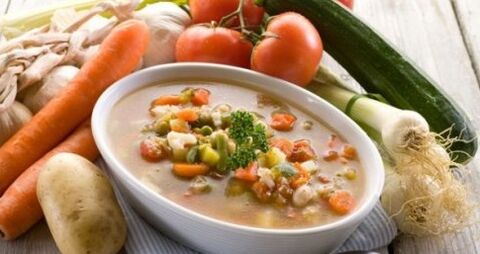
Basic rules
The main task of the diet in gastritis is to follow a diet that ensures normal digestion. The treatment table for gastritis (per day) should include:
- 90-100gr. Squirrels (and 60% animals),
- 50-80gr. Fat (75% animals)
- 300-320gr. Carbohydrates.
Diet rules for gastritis:
- Getting to know measure. In the case of gastritis, the saying "After eating a slight feeling of hunger" is more relevant than ever. Firstly, the feeling of fullness does not appear until 10-15 minutes after eating, and secondly, an overflowing stomach does not cope well with its functions, especially in gastritis.
- Diet. First of all, you should track food intake (at the same time). Second, in gastritis, food should be fractionated, 4-5 times a day, but at the same time it is necessary to refuse snacks (they provoke "excess" secretion of gastric juice and reduce its production during breakfast / lunch / dinner, which processes theProcessing and intake of food violated). You should categorically exclude reading while eating, watching TV and "running on the go".
- Rest after eating. After each meal, you need to rest for 15-20 minutes (it is not necessary to sleep). You can read a book or listen to music.
- Chew food. Chewing food for longer (at least 25-30 seconds for each piece) contributes to more thorough mechanical processing of the food, which makes the work of a sick stomach easier. In addition, hunger is satisfied faster in this case (which prevents overeating). Refusal of complex courts
The total energy value should be 2200-2800 kcal.
High acid diet
In this form of gastritis, a diet is recommended that aims to protect the stomach thermally and mechanically and to reduce gastric secretion.
Allowed products:
- Casseroles, cheesecakes, dumplings, oven-baked cheesecakes;
- Milk, in particular with tea, all types of fermented milk products, including yoghurt and yoghurt, fresh cottage cheese puree;
- fish, meat or chicken soups cooked in cereal broth;
- dry white crackers, vegetables and butter, milk soups with cereals or pasta;
- steamed omelets, pouched eggs, vegetable dishes in the form of mashed potatoes, pudding, soufflés, weak tea, sweet fruits and berries in jelly, creams and compotes;
- Veal, lean beef, chicken in the form of meatballs, pudding, zraz, steamed cutlets (1-2 times a week, lean cooked meat can be eaten in pieces).
Prohibited products:
- fatty mushroom and meat broths;
- Carbonated beverages;
- smoked meat with spices;
- Raw vegetables, pickles, pickles, flavorful vegetable snacks, lemon juice;
- Black bread.
The purpose of the diet is to aggravate high acid gastritis in order to normalize bowel and stomach function and limit thermal, chemical and mechanical stimuli.
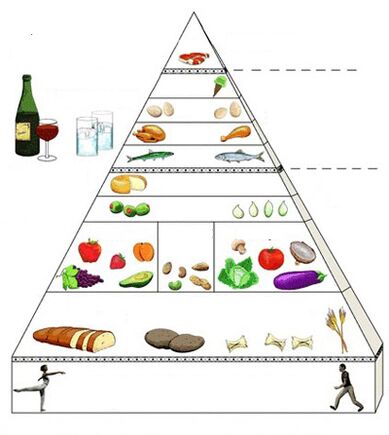
Low acid diet
The purpose of the low-acid gastritis diet is to stimulate the production of gastric juice (in moderation) as well as the mechanical protection of the stomach.
Prohibited foods in hypoacid gastritis:
- Restriction of pearl barley, legumes, millet;
- fresh bread, baked goods ("heavy" food for the stomach, makes chemical and mechanical processing difficult);
- fatty and salted fish;
- Vegetables and fruits with coarse fiber (white cabbage, beets, radishes, cucumbers, peppers), mushrooms;
- fatty meat, meat with fascia (foils), canned food, smoked meat (insufficient mechanical processing of food, excessive release of hydrochloric acid);
- spicy and salty cheeses, milk - neutralizes hydrochloric acid;
- berries with grains or thick skin (raspberries, strawberries, red currants, gooseberries, figs);
- Spices and herbs (irritate the gastric mucosa), as well as chocolate, grape juice, alcohol;
- Lard and fat from pork, beef, lamb (not absorbed due to low hydrochloric acid production, products that are difficult to digest).
Food intake should take place after the onset of hydrochloric acid secretion, that is, in the first phase (advertising or programs about food, beautiful pictures of food, "tasty" conversations can provoke the release of gastric juice).
Diet for gastritis in the acute stage
Particular attention should be paid to nutrition with gastritis in the acute stage. The requirements for products are the same as for all types of this pathology, but more stringent.
In the acute form of the disease, it is recommended:
- low-fat cottage cheese;
- yesterday's white bread and no pastries or muffins;
- lean meat only, boiled and mashed or finely chopped;
- Soups exclusively on vegetable broths;
- acid-free compotes and jelly;
- soft-boiled eggs or in the form of a steam omelette;
- Vegetable purees from the range of baby food, it is also good to borrow fish and meat purees from a jar from babies;
- Teas or infusions without sugar.
During the period of immediate exacerbation from the menu they are completely excluded:
- Products with preservatives, flavor enhancers, artificial colors;
- raw vegetables and fruits;
- Milk and milk dishes;
- all kinds of pastries except yesterday's bread;
- Margarine, edible oil and butter;
- Pearl barley;
- all kinds of beans and beans.
In addition, any general restrictions on the products themselves and the methods of making them remain in place. Usually the crisis passes in 3-4 days, then according to the general recommendations for patients with gastritis, the diet becomes more varied.
Sample menu for a week
To get an idea of the diet, you can look around for a week with recipes on the diet menu for gastritis of the stomach. There is a clear fractional diet plan: eat several times a day. Such foods for a week look attractive and cover energy needs thanks to a well thought-out calorie content.
Day 1:
- Breakfast - buckwheat, milk soufflé, tea.
- Second breakfast - 1 glass of sweet oat broth.
- Lunch - slimy rice soup, spaghetti with beef zrazy, boiled carrots and peas, cocoa with milk.
- Afternoon snack - curd made from fermented milk.
- Dinner - vegetable casserole, steamed meatballs, a light herb decoction with honey.
- Before bed - 1 glass of fruit jelly.
Day 2:
- Breakfast - boiled egg, dried bread, boiled oatmeal, apple and rose hip decoction.
- Second breakfast - boiled dried fruit compote (1 glass) and dry biscuit.
- Lunch - buckwheat soup, pumpkin puree, chicken zrazy, tea with milk (sugar can be added).
- Afternoon snack - 1 glass of milk, yogurt, kefir, and toasted toast (fried bread is not acceptable).
- Dinner - noodles with steamed beef balls, sour cream vegetable salad, cocoa. Before bed: 250 grams of low-fat fermented baking milk.
Day 3:
- Breakfast - oatmeal, boiled fish, tea with milk;
- Second breakfast - milk jelly.
- Lunch - vegetable soup with chicken, mashed potatoes and carrots, steamed schnitzel, cocoa with milk.
- Afternoon snack - curd made from fermented milk.
- Dinner - a meatball with boiled peas, toast, dried fruit compote.
- Before bed - kefir or milk.
Day 4:
- Breakfast - cottage cheese from fermented milk with honey, toast, dried fruit compote.
- Second breakfast - kefir or 1 glass of milk.
- Lunch - mashed potato soup, casserole with vegetables and rabbit, dried fruit compote.
- Afternoon snack - mousse or milk soufflé with fresh fruits.
- Dinner - congee with boiled rabbit, boiled carrots and peas, tea with milk.
- Before bed - cocoa with milk and 2 pieces of oat biscuits.
Day 5:
- Breakfast - boiled egg, dried bread, boiled oatmeal, cocoa with milk.
- Second breakfast - 1 glass of sweet oat broth.
- Lunch - pea soup, steamed fish, baked pumpkin.
- Afternoon snack - milk jelly.
- Dinner - vegetable casserole, steamed fish, rose hip broth.
- Before bed - 1 glass of kefir and oatmeal cookies.
Day 6:
- Breakfast - buckwheat milk groats, milk soufflé, tea.
- Second breakfast - baked fruit and a glass of milk.
- Lunch - soup with cauliflower, zrazy with rice, cocoa with milk.
- Afternoon snack - vegetable casserole and tea.
- Dinner - steamed fish with carrots and peas, salad with vegetables and sour cream, rose hip decoction.
Day 7:
- Breakfast - baked apples with quark and raisin filling, toast, juice.
- Second breakfast - kefir or milk.
- Lunch - vegetable soup with chicken, mashed potatoes and carrots, steamed schnitzel, cocoa with milk.
- Afternoon snack - curd made from fermented milk with honey.
- Dinner - pasta with boiled chicken, baked pumpkin, cocoa with milk.
- Before bed - 1 glass of fruit jelly.
The acute stage of the disease with such a diet quickly passes into the stage of remission of gastritis.
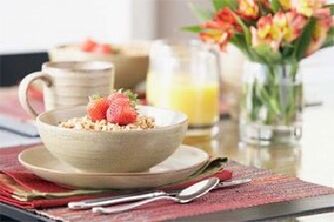
Menu for the week, option number 2
People on a gastritis diet are advised to plan their menu for a week with recipes in advance. Having a clear plan of action will help you avoid unhealthy snacks. It is much easier if the necessary foods are prepared in the patient's refrigerator. And a person knows how and what can be quickly cooked from them.
Monday:
- Tomorrow - 7: 00 am. Steamed fish schnitzel. Cooked potatoes. Tea.
- Reinforcement - 10: 00 am. Low-fat cottage cheese.
- Lunch - 13: 00. Barley soup with vegetables. Buckwheat porridge with boiled meat. Compote.
- Reinforcements - 4: 00 p. m. Sweet crackers. Carrot juice.
- Dinner - 6: 30 pm-7: 00pm. Oven-baked chicken meatballs. Mashed potatoes on the water. Charlotte. Tea.
- At night - 9: 00 p. m. A glass of low-fat kefir.
Tuesday:
- Morning - 7: 00 am. Oatmeal with egg white omelette. Tea.
- Reinforcement - 10: 00 am. Baked apples.
- Lunch - 13: 00. Low-fat vegetable soup. Congee with boiled chicken. Compote.
- Reinforcements - 4: 00 p. m. Sweet crackers. Rose hip drink.
- Dinner - 18: 30-19: 00. Mashed potatoes with a slice of lean fish. Semolina pudding. Kissel.
- To the night. A glass of low-fat kefir.
Wednesday:
- Morning - 7: 00 am. Congee with turkey meatballs. Tea with milk.
- Reinforcement - 10: 00 am. Quark casserole with low-fat sour cream.
- Lunch - 13: 00. Vegetable soup. Rabbit chops steamed with vegetable stew. Compote.
- Reinforcements - 4: 00 p. m. Sweet crackers. Rose hip drink.
- Dinner - 6: 30 p. m. - 7: 00 p. m. Oatmeal in half milk with chicken meatballs. Fresh berry juice.
- At night - 9: 00 p. m. A glass of low-fat kefir.
Thursday:
- Morning - 7: 00 am. Boiled tongue. Semolina with half milk. Tea.
- Reinforcement - 10: 00 am. Baked apple.
- Lunch - 13: 00. Vegetable soup with fine noodles. Mashed potatoes in water with boiled turkey meat. Compote.
- Reinforcements - 4: 00 p. m. Galette biscuits. Rose hip drink.
- Dinner - 18: 30-19: 00. Potato casserole with minced meat. Tea.
- At night - 9: 00 p. m. A glass of low-fat kefir.
Friday:
- Morning - 7: 00 am. Buckwheat porridge with protein omelette. Tea with milk.
- Reinforcement - 10: 00 am. Kissel.
- Lunch - 13: 00. Vegetable soup. Chicken meatballs with cooked vegetable puree. Compote.
- Reinforcements - 4: 00 p. m. Sweet crackers. Dried fruit compote.
- Dinner - 18: 30-19: 00. Mashed potatoes on the water with boiled fish. Tea.
- At night - 9: 00 p. m. A glass of low-fat kefir.
Saturday:
- Morning - 7: 00 am. Oatmeal with half milk. Steamed fish cakes made from lean fish. Tea.
- Reinforcement - 10: 00 am. Low-fat fresh cottage cheese. Baked apple.
- Lunch - 13: 00. Vegetable soup. Cooked potatoes. Beef stroganoff. Compote.
- Reinforcements - 4: 00 p. m. Sweet crackers. Tea.
- Dinner - 6: 30 p. m. - 7: 00 p. m. Fish baked in the oven. Boiled carrot puree. Tea.
- At night - 9: 00 p. m. A glass of low-fat kefir.
Sunday:
- Morning - 7: 00 am. Oven-baked meat soufflé. Oatmeal with half milk. Tea.
- Reinforcement - 10: 00 am. Carrot and apple soufflé.
- Lunch - 13: 00. Vegetable soup. Buckwheat porridge with steamed rabbit meat cutlets. Carrot and banana juice.
- Reinforcements - 4: 00 p. m. Sweet crackers. Tea.
- Dinner - 18: 30-19: 00. Mashed potatoes on the water. Boiled fish. Rose hip drink.
- At night - 9: 00 p. m. A glass of low-fat kefir.
How much diet should be followed in case of gastric mucosal inflammation? Strict control is required during an exacerbation and for the first few months after it. But ideally, a patient diagnosed with gastritis should stick to the recommended table during remission. However, menu extensions and holiday exceptions are possible. If only within reason, and if it is not about coffee, cigarettes, alcohol and fatty foods.
Recipes for gastritis
Dietetics offers several recipes to diversify the diet for gastritis in adults and children. They have delicate heat treatment regimes, do not use spices and fats.
The most important nutritional rule for a sick stomach: the food should be of medium temperature. A hot or cold meal makes ulcerative gastritis worse. Below we describe some recipes for eating at home with stomach upsets.

Beef zrazy
Products:
- 200 g of lean veal or beef;
- 20 g of boiled rice;
- 30 grams of crackers;
- half a teaspoon of butter.
Preparation:
- Mince the meat in a blender or meat grinder.
- Add crackers.
- Shape a cake.
- Put rice and oil in the middle. It will add a creamy taste.
- Shape zraz and place in a water bath or multicooker for 15 minutes.
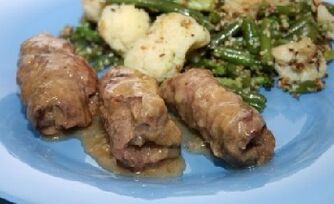
Vapor pearls
Ingredients:
- Beef - 200 g,
- Roll - 10 g,
- Oil - 10 g.
Combine the meat chopped in a meat grinder with an old loaf soaked in water and pass through a meat grinder. Add water, salt and mash well. Shape and steam the meatballs.

Fish jelly
Products:
- Pikeperch - 200 g,
- Carrots - 5 g
- Gelatin, egg - 1/4.
Preparation:
- The cleaned fish is cut into small pieces and cooked in a pre-cooked vegetable broth.
- Swollen gelatin is added to the resulting broth, mixed well and filtered through double gauze.
- The fish is placed in a bowl or form, the bottom is decorated with chopped carrots, poured with strained broth and allowed to cool.
- Pieces of fish are poured with broth and allowed to cool.

Creamy quark
Products:
- Curd mass - 100 g,
- Sugar - 25 g
- Butter, egg - 1/4,
- sour cream - 20 g,
- Vanilla sugar,
- Milk - 30 g,
- Flour - 5 g.
Preparation:
- A sauce is made from flour, milk, eggs and sugar.
- Egg yolks are ground with wheat flour and sugar,
- poured with boiling milk and heated, stirring constantly, until thickened,
- Oil is added to the cooled mass.
- grated cottage cheese, vanilla sugar, sour cream are added to the resulting mixture,
- the whole mass is well ground and laid out in a salad bowl.

Milk soup with breadcrumbs
Products:
- Milk - 400 g,
- Sugar, crackers - 50 g,
- Egg yolk - 1/3,
- Vanilla, oil, water - 50 g.
Preparation:
- Crushed white crackers are added to the milk and water is brought to a boil.
- Egg yolks ground with sugar are added to the milk taken from the fire, butter is added before serving.
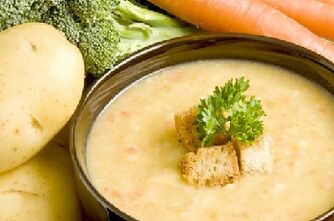
Can I . . .?
What is allowed and what is not? List of staple foods and drinks.
- Fish - only low-fat species of marine fish such as saithe, cod, hake. Among the river fish, pikeperch and pike are the best. It is better to completely refuse canned fish and fried fish, during their production all the useful properties of fish are lost, and a lot of spices and preservatives, carcinogens can be more than recovered. As with meat, it's best to steam the fish to limit the seasoning.
- Coffee - It is absolutely impossible to drink black coffee with gastritis on an empty stomach, even in large quantities, especially if you have elevated stomach acid. If the acid content is low, coffee or cocoa with milk is allowed, but only in limited quantities.
- Meat - you can eat with gastritis, but only low-fat varieties - beef, veal, chicken, rabbit. Steam chops are especially useful for gastritis as the meat is finely chopped and steamed. If it is only steamed meat, it should be chewed very carefully and not overworked, as every meat product is a burden on the stomach. Of course, neither smoked nor uncooked smoked sausages and sausages can be used for gastritis.
- Cheese - spicy or too salty cheeses are not allowed with any gastritis, even ordinary hard cheese should be eaten in small slices in limited quantities.
- Bananas - Can Bananas Be Used For Gastritis? This is a healthy fruit that is low in fiber, soft, easy to digest, and high in nutrients that the body needs. And although Diet No. 5 prohibits fruits like dates and bananas, many gastroenterologists believe that their moderate consumption cannot harm, and bananas should and can be eaten with gastritis.
- Watermelon is something to eat with gastritis, but very little. For each acid, you can only eat 1-2 slices.
- Melon is almost the hardest plant product not only for the stomach, but also for the pancreas and gallbladder. The digestive tract of a perfectly healthy person has a hard time with melon, so anyone suffering from gastritis should avoid such a dubious product.
- Chocolate - it is better to abandon this product entirely.
- Nuts, seeds, legumes - Nuts should not be used for gastritis, the same applies to seeds and legumes.
- Honey can be used because it has wound healing properties and is considered an enriched and useful product. All is well in moderation, however, especially since many people may be allergic to bee products.
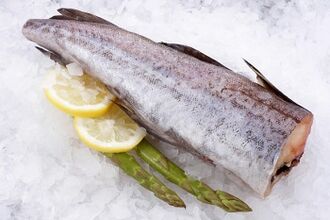
Is it Possible to Get Rid of Gastritis Completely?
In mild cases, with superficial gastritis, it is possible to completely cure it if you lead a healthy lifestyle and observe the following strict rules, which in practice turns out to be quite a difficult task:
- Meals should be taken 5-6 times a day at certain times, the last meal should be taken at least 2 hours before going to bed.
- Constant adherence to a diet, no dry food, fast food.
- Avoid smoking and drinking.
- Avoid overeating and long breaks in meals.
- Insufficient physical exertion, constantly monitor the state of the body, do not overexert, do not overexert, sleep at least 8 hours at night and preferably 1 hour during the day.
It is also worth working on yourself to develop stress resistance (stress resistance) or to rule out psycho-emotional overload.














































































